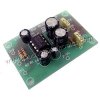electronito
New Member
Hi there,
I just built a 1W Stereo Amplifier Module to use with my bent toy instruments and I want to be able to control the volume. The information sheet that came with the kit says to use speakers with a minimum of 1W, 4 or 8 Ohms. My first question is, can i use a 40W 6 Ohms speakers with it? Will it produce unwanted noise?
And my most needed help comes with the audio taper pot I should use inserted somewhere in the middle of the cable (an Y adapter Audio cable: in one side a 1/8 plug and in the other sides two RCA plugs, left and right) that goes connected from the bent instrument's output to the INPUT RCA jacks on the amplifier. i know radioshack sells the "100k dual-ganged stereo volume control" but I do not know if 100k is too much. Does anybody knows if I need a 5-25k stereo volume control instead?
thanks
I just built a 1W Stereo Amplifier Module to use with my bent toy instruments and I want to be able to control the volume. The information sheet that came with the kit says to use speakers with a minimum of 1W, 4 or 8 Ohms. My first question is, can i use a 40W 6 Ohms speakers with it? Will it produce unwanted noise?
And my most needed help comes with the audio taper pot I should use inserted somewhere in the middle of the cable (an Y adapter Audio cable: in one side a 1/8 plug and in the other sides two RCA plugs, left and right) that goes connected from the bent instrument's output to the INPUT RCA jacks on the amplifier. i know radioshack sells the "100k dual-ganged stereo volume control" but I do not know if 100k is too much. Does anybody knows if I need a 5-25k stereo volume control instead?
thanks





